Yuening called and told me we were going somewhere with her friend, Lan Wen
Ming the next day, and that I would get a chance to see the rural areas in SW
China. We say "countryside" because rural has a double-R, a
"no-no" for everyone except me.
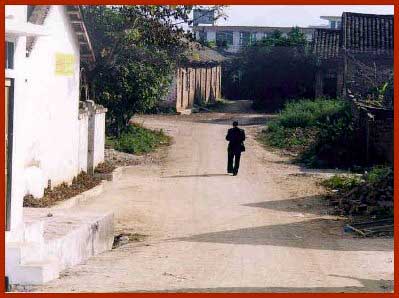 My first trip to the rural areas was reasonably benign. The driver, another
of General Yuening’s Lieutenants, was a young electrical engineer from Nanning
whose wife was a doctor for the Guanxi Police. We drove to a small town (about
80,000 people) that had
been the hometown of Yuening’s parents many years ago; it was about 1 ½ hours
from Nanning.
My first trip to the rural areas was reasonably benign. The driver, another
of General Yuening’s Lieutenants, was a young electrical engineer from Nanning
whose wife was a doctor for the Guanxi Police. We drove to a small town (about
80,000 people) that had
been the hometown of Yuening’s parents many years ago; it was about 1 ½ hours
from Nanning.
When traveling in China, it is probably best to describe your journeys in the
metric of time, rather than distance. It can make a difference in the accuracy
of measurement. To get to the older folks stomping ground, we had to traverse
what passes for a major cross-country highway here. It is mostly paved in what
we sometimes call chip-and-seal; small gravel laid down and covered with thick
oil that hardens to an asphalt-like surface; the same as the rural secondary
road to my house. My road probably averages a car every 2-5 minutes, and
therefore can well handle the occasional large truck that takes the hilly, curvy
and many-small-bridged, country road. The road we drove from Nanning was
something quite different. The traffic was heavy and constant and made up of
pedestrians, all types of bicycles, scooters (2 and 3 wheel), cars and heavy
gravel and sugar cane trucks that took their half of the road out of the middle.
For good measure, a few slow-moving ox-drawn carts were thrown in fat
sporadic intervals. Just to make
things even more interesting, heavy dust and pollution reduced visibility to less
than 100 meters much of the way. The trucks had beaten any smoothness from the path and every few
kilometers the pavement either disappeared altogether or was traversed by a
partially filled trench for water pipes, or anything else that anyone with a
shovel wanted to see planted. The way was lined with 2 to 3-foot diameter trees every
10 yards or so on both sides. These were carefully whitewashed to a height of 4
feet or so. The shoulder, such as it was, consisted of about 6" of dirt
preceding a ditch of varying depth and width. I would normally drive such an avenue at
about 25 miles per hour – we bounced down this thoroughfare at around 50-60, and a
rough transit it was.
sugar cane trucks that took their half of the road out of the middle.
For good measure, a few slow-moving ox-drawn carts were thrown in fat
sporadic intervals. Just to make
things even more interesting, heavy dust and pollution reduced visibility to less
than 100 meters much of the way. The trucks had beaten any smoothness from the path and every few
kilometers the pavement either disappeared altogether or was traversed by a
partially filled trench for water pipes, or anything else that anyone with a
shovel wanted to see planted. The way was lined with 2 to 3-foot diameter trees every
10 yards or so on both sides. These were carefully whitewashed to a height of 4
feet or so. The shoulder, such as it was, consisted of about 6" of dirt
preceding a ditch of varying depth and width. I would normally drive such an avenue at
about 25 miles per hour – we bounced down this thoroughfare at around 50-60, and a
rough transit it was.
I have mentioned that the general state of repair for most Chinese vehicles
is somewhat poor; this was an understatement. I have ridden in very few that
seemed safe. Mostly, the problem seemed to be related to worn suspensions,
beaten into shards by the constant abuse forced on them by hurried drivers and
moon-crater roads and streets. Almost everything I rode in, or on, sounded like
something was ready to fall off and kill some unsuspecting cyclist or ox-cart
driver. My knowledge
of automobiles is limited but, as Agatha Christie's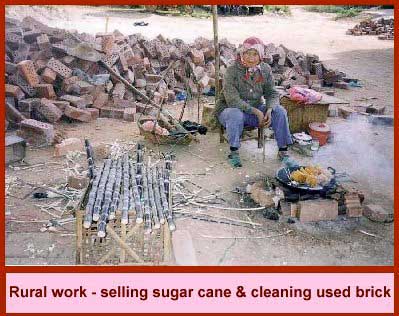 Poirot once said, "I
know little of these automobiles, but I do know that they should have four
wheels and that these should be firmly attached." I heard body panels
flapping, ball joints that rattled like the front wheels were in imminent danger
of separating from the car and doors that were so loose I held tight to the
handle to feel somewhat safe from falling out. It isn’t that these things
occur that is unusual, is that they are all but ubiquitous here.
Poirot once said, "I
know little of these automobiles, but I do know that they should have four
wheels and that these should be firmly attached." I heard body panels
flapping, ball joints that rattled like the front wheels were in imminent danger
of separating from the car and doors that were so loose I held tight to the
handle to feel somewhat safe from falling out. It isn’t that these things
occur that is unusual, is that they are all but ubiquitous here.
We arrived in the small town, Shiang Aiao Chen, after about an hour and a
half traveling past rice, sugar cane, banana and vegetable fields tilled by
oxen, walk-behind tractors and by hand. This place of about 40,000 people is a
sugar town and they’ve got sugar cane like Iowa’s got corn
The sugar mill burns something (maybe cane after the sugar is extracted?) in
its processing, and the pall of black smoke, mixed with pollution and dust from
the dirt roads, is so thick as to limit visibility severely. Large tandem trucks
loaded w/cane rumble and rattle down every road and street. Some of the cane is
cut into 2-3" diameter by 1" thick wafers to be dried on the road when
sunny. These hockey-pucks of sugar are sent to distilleries to be made into
liquor. The whiskey must taste like diesel fumes instead of oaken barrels here.
I doubt 12 years of aging will clear that up much.
After lunch, we to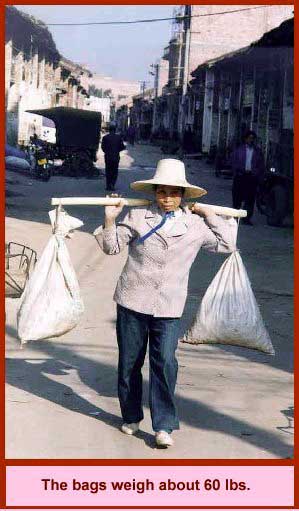 ok a short walk through a market that made the smelly
crowded markets of Nanning look like Safeways in the U.S. Another assaultive
ride back to Nanning and we are back in Nanning for the evening.
ok a short walk through a market that made the smelly
crowded markets of Nanning look like Safeways in the U.S. Another assaultive
ride back to Nanning and we are back in Nanning for the evening.
Ning-Ming, Our Second Rural Outing
Click below for pictures accompanying this portion
PICTURE GALLERY #3 -
THE NING-MING RIVER TRIP
Our second foray to the countryside was quite different. We boarded a very
clean and well-turned-out train to Ning-Ming, another sugar town of about 80k
people, near the Vietna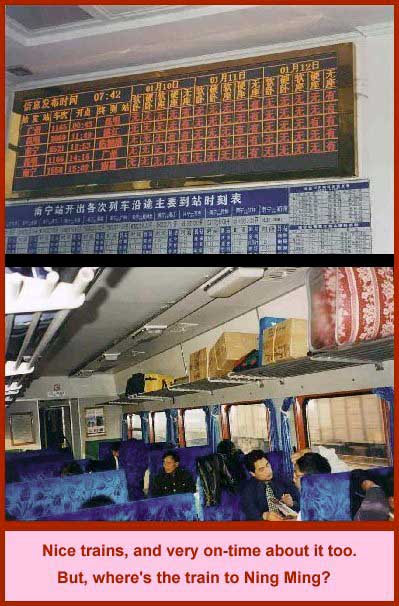 m border. We rode second-class for the 150-mile
trip; this level is called "soft seat" for some unfathomable reason. The
seating is 3 people sitting facing 3 other people across a small table, this on
each side of the aisle. The "seats" are straight-backed wood benches covered
with ¼" of foam rubber and a cloth seat cover; almost as comfortable as a
church pew. When my watch chimed 0800, the wheels turned like a
switch had been flipped – the Swiss got nothing on China Rail. Stewardesses come through
hawking candy, nuts and drinks about every 20 minutes. These goods are
reasonably priced (about 1 ½ times the street price) unlike the U.S., where
anything bought in transit or at a terminal is 3-6 times the normal price.
Altogether, this was a very smooth and comfortable trip. Trains are the way to
go in China.
m border. We rode second-class for the 150-mile
trip; this level is called "soft seat" for some unfathomable reason. The
seating is 3 people sitting facing 3 other people across a small table, this on
each side of the aisle. The "seats" are straight-backed wood benches covered
with ¼" of foam rubber and a cloth seat cover; almost as comfortable as a
church pew. When my watch chimed 0800, the wheels turned like a
switch had been flipped – the Swiss got nothing on China Rail. Stewardesses come through
hawking candy, nuts and drinks about every 20 minutes. These goods are
reasonably priced (about 1 ½ times the street price) unlike the U.S., where
anything bought in transit or at a terminal is 3-6 times the normal price.
Altogether, this was a very smooth and comfortable trip. Trains are the way to
go in China.
When we got to Ning Ming, transportation got a little different. Our
companion, Lan Wen Ming, led us to her brother on the platform. Apparently, in
Ning Ming he is the "fix-it" guy - the Arranger. We were directed to what passes as a taxi in
rural China – I call them cycle taxis. These are 125cc small motorcycles with
the back wheel hacked off and a 2-wheel covered cart welded on its place. The
cart has a bench on each side that will fit 3 Chinese people, with 8 chickens in
baskets, 2-50kg bags of rice and a pig on the floor between them. Ours, being reserved by Ming’s
brother, held only the 4 of us. We were 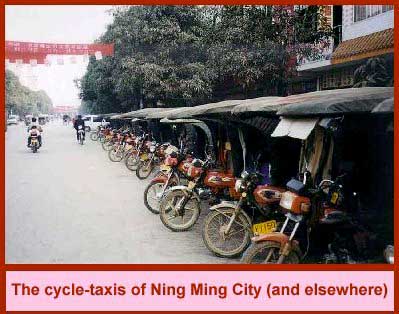 taken to a restaurant for noodles and
fried peppers – yummy. We returned to the waiting 3-wheeler and were taken
about 5 miles down a dirt road. My Chinese was not good enough to have the
vaguest idea of where we were headed so, like most of our outings, I just rode
along until we got there. Forrest Gump was right, life in China is like a box of
chocolates, each bite a surprise – this one was a doozy.
taken to a restaurant for noodles and
fried peppers – yummy. We returned to the waiting 3-wheeler and were taken
about 5 miles down a dirt road. My Chinese was not good enough to have the
vaguest idea of where we were headed so, like most of our outings, I just rode
along until we got there. Forrest Gump was right, life in China is like a box of
chocolates, each bite a surprise – this one was a doozy.
We pulled up to a quay on a green river where there was an excursion boat
parked at the dock. Ming’s brother waved as he disappeared in a dust cloud and
we headed for the boat, and right across it’s bow to a little wooden sampan
that had been hidden from view. Made of wood, about 20’ long and 5’ across,
this covered craft looked like it would sink if I set food aboard – it didn’t,
and was actually set up to seat 20, 10 to a side. The coxswain's hand cranked the
smoke-belching outboard to life and we were off – I still didn’t know where.
We cruised slowly down river between beautiful green mountains reminiscent of
Guilin. They rose from the mist like monsters awakened by the raucous motor.
After 1 ½ hours, I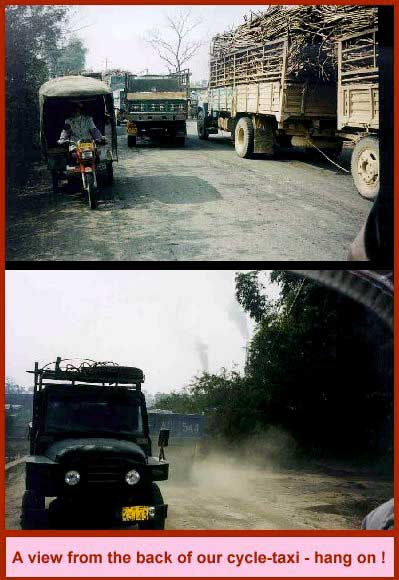 was starting to run low on film when we finally got to our
secret destination which was a huge cliff wall covered in hieroglyphics painted
red. Ming explained that it was reachable only by boat and was discovered about
25 years ago. The red paint was quite vivid and I was told that the drawings were
about 2200 years old. Scientists are currently investigating the paint to see
just what this stuff was made of that had been weathering for 20 centuries and
was still bright. I am sure that we will see it on highways and other high-use
areas soon. Made me wonder why I have to paint my house every 5 years. We
walked around awhile, looking at the wall from a path cut into the mountainside, and then headed back up-river.
was starting to run low on film when we finally got to our
secret destination which was a huge cliff wall covered in hieroglyphics painted
red. Ming explained that it was reachable only by boat and was discovered about
25 years ago. The red paint was quite vivid and I was told that the drawings were
about 2200 years old. Scientists are currently investigating the paint to see
just what this stuff was made of that had been weathering for 20 centuries and
was still bright. I am sure that we will see it on highways and other high-use
areas soon. Made me wonder why I have to paint my house every 5 years. We
walked around awhile, looking at the wall from a path cut into the mountainside, and then headed back up-river.
There were all sorts of activity along the waterway, kids playing, oxen
plowing, women washing clothes and people fishing. All along, there were many square
frames about 6’x6’ anchored and floating in the water. I asked what these
were and was told that it was food for pigs. I guess grain here goes straight to
the plate. Even the rivers are used for horticulture because land is so
expensive; more about that later.
When we arrived back at the landing, our cycle-taxi and Ming’s brother were
waiting for us. The 4-hour boat trip and admission to the hieroglyphics park
cost 100 RMB for all 3 of us – including the cycle-taxi fare both ways.
We walked along the main street of Ning Ming, dodging the occasional pig or
shoeshine stand until we arrived at the restaurant for supper. I explained as
well as I could that I wanted the luke-warm food on the buffet to be 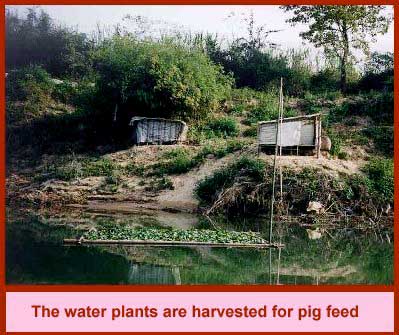 served hot.
I always insist that everything here, especially meat and eggs, be well-done and
hot in public eateries. This time it worked as well as any other thing I try
here involving communication – it was so hot with red pepper I broke out in a sweat on the first bite.
Of course, hot has two meanings and Murphy's law says that I will always
communicate the wrong one. It was at dinner I found out that wee were taking a
bus back to Nanning, and then I was really hot.
served hot.
I always insist that everything here, especially meat and eggs, be well-done and
hot in public eateries. This time it worked as well as any other thing I try
here involving communication – it was so hot with red pepper I broke out in a sweat on the first bite.
Of course, hot has two meanings and Murphy's law says that I will always
communicate the wrong one. It was at dinner I found out that wee were taking a
bus back to Nanning, and then I was really hot.
I’ve been on busses in China before, and from my experience they come in 2
varieties – bad and really bad. There are double-deckers that have
sleeping/reclining rocks on both levels. Single level ones that mimic Greyhound
vehicles in a sad way, with seats, of course, to fit small Chinese derriers.
These are usually dirty and in poor cosmetic and mechanical condition; their
suspensions long ago given over to the Chinese roads. I am told that there are
good busses here that are clean and of newer vintage, but have never seen such
mythical things actually driven with passengers.
Along with the passengers, assorted freight, personal goods, fruit, livestock
(alive or dead) and other things are stuffed around the passengers like packing
a suitcase. The cargo, combined with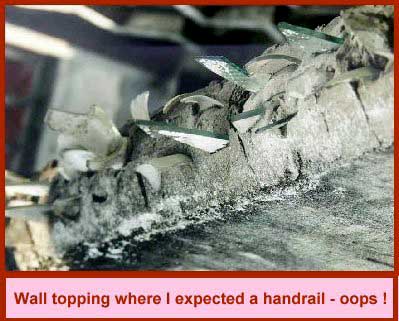 hawking Chinese farmers spitting on the floor and
depositing their banana and orange peels there, makes for an aromatic and sometimes
slippery ride. Most of the cargo and passengers become rearranged as the
apparently insane drivers blast along the rutted roads at least twice the safe
or posted speed: They drive without lights at night, pass on blind corners and
hills, tailgate and generally defy all reasonably common sense rules of safety
while chatting with the pretty girl that usually gets the best seat next to the
driver. Never take a bus in China if you can avoid it. The fare is comparable to
the train and the trip will scare the bejesus out of you unless maybe your last
name is Knievel, and I dare even old Evil to take this trip.
hawking Chinese farmers spitting on the floor and
depositing their banana and orange peels there, makes for an aromatic and sometimes
slippery ride. Most of the cargo and passengers become rearranged as the
apparently insane drivers blast along the rutted roads at least twice the safe
or posted speed: They drive without lights at night, pass on blind corners and
hills, tailgate and generally defy all reasonably common sense rules of safety
while chatting with the pretty girl that usually gets the best seat next to the
driver. Never take a bus in China if you can avoid it. The fare is comparable to
the train and the trip will scare the bejesus out of you unless maybe your last
name is Knievel, and I dare even old Evil to take this trip.
We arrive at the bus station and I am assured that we are not going by
chicken bus, my term for Chinese busses that gets laughs from everyone. I am
told we will take one of the fabled "good" busses – don’t worry.
Thirty minutes after our scheduled departure, we were informed that our bus had
had an accident and that there would not be another until morning – the day
before my scheduled departure. Not only was my confidence not inspired by the
wreck of our intended conveyance, the complications of missing international
flights were too much to even think about. I said we should hire a taxi or car
as I must be back tonight to pack and prepare for my trip home. Ming’s brother
left for a few minutes and when he came back he said there would be a bus in an
hour. Mr. FIX IT.
As we were waiting, the room started to fill with passengers and cargo.
Eventually, I was vindicated; 5 baskets, partially covered with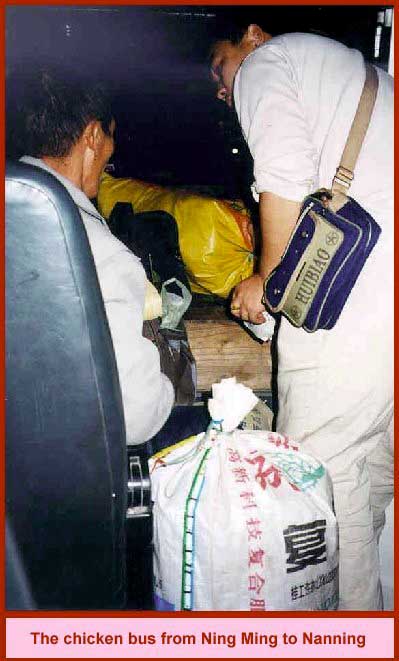 burlap sacks,
arrived on the floor. Wriggling and protruding from an opening in each was a
cute little pig snout.
burlap sacks,
arrived on the floor. Wriggling and protruding from an opening in each was a
cute little pig snout.
After a delayed departure, due to the combined effects of the driver’s
hormones and the tight jeans on the front seat passenger, we started on our 3 ½
hour trip to Nanning. At 8pm the dirt and chip-n-seal road was crowded with
pedestrians, bikes, cycles, cars, busses and trucks with the odd ox-or donkey
cart thrown in for good measure. About ½ of the motor vehicles had no head- or
taillights – or didn’t use them. Those that did use headlights kept them on
hi-beam all the time. Combined with the Chinese drivers’ vision of getting
anywhere before anyone else, putting all this in motion on a dark night with
poor visibility seemed a disaster waiting for a place to happen. About ½ of
this melee were trucks well over 20 tons loaded with sugar cane or rock.
This was the roughest ride I have ever taken – anywhere. I was literally
bounced clear of the seat on the larger bumps. I stood for the latter ½ of the
trip because my butt couldn’t take anymore. This part of the journey saw my
head pounded against the roof when we hit the big ones - and they all seemed to
be big ones. Most importantly, we
made it to Nanning that evening, albeit with head – and butt aches. The whole
day's adventure for the 3 of us cost about 380 RMB, about $47.50 US.
 My first trip to the rural areas was reasonably benign. The driver, another
of General Yuening’s Lieutenants, was a young electrical engineer from Nanning
whose wife was a doctor for the Guanxi Police. We drove to a small town (about
80,000 people) that had
been the hometown of Yuening’s parents many years ago; it was about 1 ½ hours
from Nanning.
My first trip to the rural areas was reasonably benign. The driver, another
of General Yuening’s Lieutenants, was a young electrical engineer from Nanning
whose wife was a doctor for the Guanxi Police. We drove to a small town (about
80,000 people) that had
been the hometown of Yuening’s parents many years ago; it was about 1 ½ hours
from Nanning. sugar cane trucks that took their half of the road out of the middle.
For good measure, a few slow-moving ox-drawn carts were thrown in fat
sporadic intervals. Just to make
things even more interesting, heavy dust and pollution reduced visibility to less
than 100 meters much of the way. The trucks had beaten any smoothness from the path and every few
kilometers the pavement either disappeared altogether or was traversed by a
partially filled trench for water pipes, or anything else that anyone with a
shovel wanted to see planted. The way was lined with 2 to 3-foot diameter trees every
10 yards or so on both sides. These were carefully whitewashed to a height of 4
feet or so. The shoulder, such as it was, consisted of about 6" of dirt
preceding a ditch of varying depth and width. I would normally drive such an avenue at
about 25 miles per hour – we bounced down this thoroughfare at around 50-60, and a
rough transit it was.
sugar cane trucks that took their half of the road out of the middle.
For good measure, a few slow-moving ox-drawn carts were thrown in fat
sporadic intervals. Just to make
things even more interesting, heavy dust and pollution reduced visibility to less
than 100 meters much of the way. The trucks had beaten any smoothness from the path and every few
kilometers the pavement either disappeared altogether or was traversed by a
partially filled trench for water pipes, or anything else that anyone with a
shovel wanted to see planted. The way was lined with 2 to 3-foot diameter trees every
10 yards or so on both sides. These were carefully whitewashed to a height of 4
feet or so. The shoulder, such as it was, consisted of about 6" of dirt
preceding a ditch of varying depth and width. I would normally drive such an avenue at
about 25 miles per hour – we bounced down this thoroughfare at around 50-60, and a
rough transit it was. Poirot once said, "I
know little of these automobiles, but I do know that they should have four
wheels and that these should be firmly attached." I heard body panels
flapping, ball joints that rattled like the front wheels were in imminent danger
of separating from the car and doors that were so loose I held tight to the
handle to feel somewhat safe from falling out. It isn’t that these things
occur that is unusual, is that they are all but ubiquitous here.
Poirot once said, "I
know little of these automobiles, but I do know that they should have four
wheels and that these should be firmly attached." I heard body panels
flapping, ball joints that rattled like the front wheels were in imminent danger
of separating from the car and doors that were so loose I held tight to the
handle to feel somewhat safe from falling out. It isn’t that these things
occur that is unusual, is that they are all but ubiquitous here. ok a short walk through a market that made the smelly
crowded markets of Nanning look like Safeways in the U.S. Another assaultive
ride back to Nanning and we are back in Nanning for the evening.
ok a short walk through a market that made the smelly
crowded markets of Nanning look like Safeways in the U.S. Another assaultive
ride back to Nanning and we are back in Nanning for the evening. m border. We rode second-class for the 150-mile
trip; this level is called "soft seat" for some unfathomable reason. The
seating is 3 people sitting facing 3 other people across a small table, this on
each side of the aisle. The "seats" are straight-backed wood benches covered
with ¼" of foam rubber and a cloth seat cover; almost as comfortable as a
church pew. When my watch chimed 0800, the wheels turned like a
switch had been flipped – the Swiss got nothing on China Rail. Stewardesses come through
hawking candy, nuts and drinks about every 20 minutes. These goods are
reasonably priced (about 1 ½ times the street price) unlike the U.S., where
anything bought in transit or at a terminal is 3-6 times the normal price.
Altogether, this was a very smooth and comfortable trip. Trains are the way to
go in China.
m border. We rode second-class for the 150-mile
trip; this level is called "soft seat" for some unfathomable reason. The
seating is 3 people sitting facing 3 other people across a small table, this on
each side of the aisle. The "seats" are straight-backed wood benches covered
with ¼" of foam rubber and a cloth seat cover; almost as comfortable as a
church pew. When my watch chimed 0800, the wheels turned like a
switch had been flipped – the Swiss got nothing on China Rail. Stewardesses come through
hawking candy, nuts and drinks about every 20 minutes. These goods are
reasonably priced (about 1 ½ times the street price) unlike the U.S., where
anything bought in transit or at a terminal is 3-6 times the normal price.
Altogether, this was a very smooth and comfortable trip. Trains are the way to
go in China. taken to a restaurant for noodles and
fried peppers – yummy. We returned to the waiting 3-wheeler and were taken
about 5 miles down a dirt road. My Chinese was not good enough to have the
vaguest idea of where we were headed so, like most of our outings, I just rode
along until we got there. Forrest Gump was right, life in China is like a box of
chocolates, each bite a surprise – this one was a doozy.
taken to a restaurant for noodles and
fried peppers – yummy. We returned to the waiting 3-wheeler and were taken
about 5 miles down a dirt road. My Chinese was not good enough to have the
vaguest idea of where we were headed so, like most of our outings, I just rode
along until we got there. Forrest Gump was right, life in China is like a box of
chocolates, each bite a surprise – this one was a doozy. was starting to run low on film when we finally got to our
secret destination which was a huge cliff wall covered in hieroglyphics painted
red. Ming explained that it was reachable only by boat and was discovered about
25 years ago. The red paint was quite vivid and I was told that the drawings were
about 2200 years old. Scientists are currently investigating the paint to see
just what this stuff was made of that had been weathering for 20 centuries and
was still bright. I am sure that we will see it on highways and other high-use
areas soon. Made me wonder why I have to paint my house every 5 years. We
walked around awhile, looking at the wall from a path cut into the mountainside, and then headed back up-river.
was starting to run low on film when we finally got to our
secret destination which was a huge cliff wall covered in hieroglyphics painted
red. Ming explained that it was reachable only by boat and was discovered about
25 years ago. The red paint was quite vivid and I was told that the drawings were
about 2200 years old. Scientists are currently investigating the paint to see
just what this stuff was made of that had been weathering for 20 centuries and
was still bright. I am sure that we will see it on highways and other high-use
areas soon. Made me wonder why I have to paint my house every 5 years. We
walked around awhile, looking at the wall from a path cut into the mountainside, and then headed back up-river. served hot.
I always insist that everything here, especially meat and eggs, be well-done and
hot in public eateries. This time it worked as well as any other thing I try
here involving communication – it was so hot with red pepper I broke out in a sweat on the first bite.
Of course, hot has two meanings and Murphy's law says that I will always
communicate the wrong one. It was at dinner I found out that wee were taking a
bus back to Nanning, and then I was really hot.
served hot.
I always insist that everything here, especially meat and eggs, be well-done and
hot in public eateries. This time it worked as well as any other thing I try
here involving communication – it was so hot with red pepper I broke out in a sweat on the first bite.
Of course, hot has two meanings and Murphy's law says that I will always
communicate the wrong one. It was at dinner I found out that wee were taking a
bus back to Nanning, and then I was really hot. hawking Chinese farmers spitting on the floor and
depositing their banana and orange peels there, makes for an aromatic and sometimes
slippery ride. Most of the cargo and passengers become rearranged as the
apparently insane drivers blast along the rutted roads at least twice the safe
or posted speed: They drive without lights at night, pass on blind corners and
hills, tailgate and generally defy all reasonably common sense rules of safety
while chatting with the pretty girl that usually gets the best seat next to the
driver. Never take a bus in China if you can avoid it. The fare is comparable to
the train and the trip will scare the bejesus out of you unless maybe your last
name is Knievel, and I dare even old Evil to take this trip.
hawking Chinese farmers spitting on the floor and
depositing their banana and orange peels there, makes for an aromatic and sometimes
slippery ride. Most of the cargo and passengers become rearranged as the
apparently insane drivers blast along the rutted roads at least twice the safe
or posted speed: They drive without lights at night, pass on blind corners and
hills, tailgate and generally defy all reasonably common sense rules of safety
while chatting with the pretty girl that usually gets the best seat next to the
driver. Never take a bus in China if you can avoid it. The fare is comparable to
the train and the trip will scare the bejesus out of you unless maybe your last
name is Knievel, and I dare even old Evil to take this trip. burlap sacks,
arrived on the floor. Wriggling and protruding from an opening in each was a
cute little pig snout.
burlap sacks,
arrived on the floor. Wriggling and protruding from an opening in each was a
cute little pig snout.